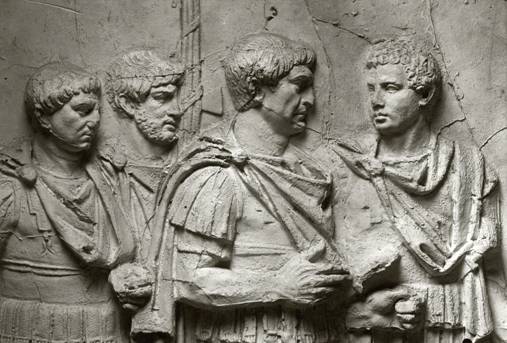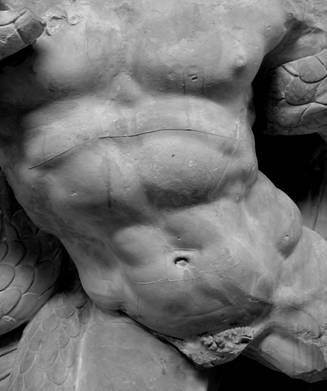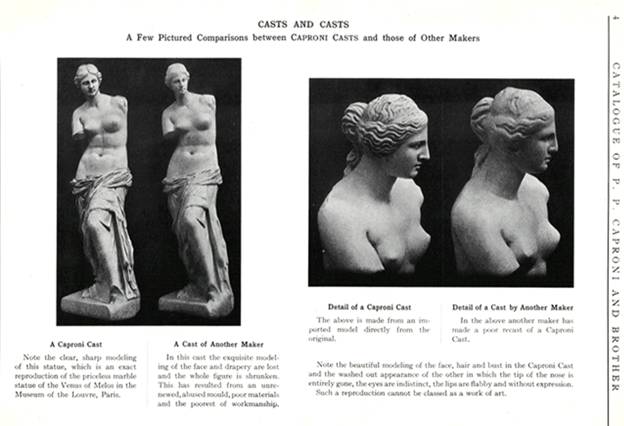Digital Sculpture Project: Casts
Fidelity and Technique of Plaster Casts
Andrea Felice
English translation by Bernard Frischer
December, 2009
If our goal is to determine a sculptural cast's fidelity in terms of overall dimensions and of the surface, we must first make a judgment about the qualitative reliability of the cast itself. Here I will discuss the fidelity of the cast understood as reproduction of a statue by means of direct contact as distinct from a copy produced through laser scanning and 3D digital restoration.
The cast, as is well-known, is produced through a mechanical process entailing a transfer from one material to another by means of a mold, or impression, taken directly from the original work. The result is a negative from which one or more casts can be obtained. This complicated process is called molding and is as old as Classical sculpture itself.
To judge the fidelity of a cast it is doubtless necessary to consider the technique utilized when the cast itself was executed: two plaster casts of the same work, produced with different techniques, can present notable differences both between each other and the original statue.
The technique of molding, considered an art in itself and utilized from time immemorial in sculptorsâ workshops, was perfected and refined in the course of its development—particularly in the 19th and 20th centuries—in tandem with the evolution of technology. Leaving aside the basic principles which govern the work process, this technical development occurred because of the introduction of new materials.
In executing a cast and a mold today, new materials such as RTV ("Room Temperature Vulcanizing") silicone (for vulcanization, polyaddition, or for polycondensation) and the resins (polyesters, acrylics, or epoxies) are used in place of traditional alabaster modeling plaster. Non-invasive and removable mold-release, as well as protective coatings, has been employed for its capacity of leaving unchanged surfaces and patinas of bronze and marble originals.
The use of silicone rubber mold has made it possible both to simplify the work of making the mold of a statue and to raise the quality of the surface detail to an unprecedented degree. But there are countless examples of plaster casts from the 19th century or even earlier that are of the highest quality and fidelity and which were obtained from plaster piece-molds executed with the cast-makerâs consummate skill.
The plaster piece-mold (Italian: forma buona) is the exemplary mold from a technical point of view. The basic principles of molding are based upon this technique. Some mold-release is spread over the original work of art, and directly over the sculpted or modeled surface the plaster piece-molds are executed for each undercut. The number of pieces (Italian: tasselli) and their shape or dimension vary according to the shape of the sculpted shape. Over all the pieces a cover is then created which is called the mother mold. Inside are placed the pieces, and the mother mold takes the imprint of all the remaining parts without undercuts. This type of mold, now rarely used, was created in several sections when the goal was to mold a statue or a sculptural group creating a cast composed of various parts which were assembled later.
In this case, the factors that might compromise the complete fidelity of the plaster cast with respect to the original are: the presence of numerous pieces which leave characteristic lines (called âseamsâ) along the joints; and the parts of the cast reassembled later (or capable of being dismantled) such as arms, the head, parts of the drapery, etc.
We know that during the phase of setting plaster develops an exothermic action with consequent volumetric expansion on the order of 0.2%.[1] Such variation of volume is temporary and is limited to this phase, after which the plaster returns to its exact initial volume. Accordingly, this physical phenomenon should not be considered a negative influence on the fidelity of plaster casts. Plaster is the material par excellence in the production of sculptural casts owing to its ease of use, malleability, widespread availability, its granular fineness and thus its notable ability to reproduce detail, its remarkable mechanical resistance (13 N/mm2), its moderate weight, and its excellent rendering of light and shade.
The same process was used in making clay piece-molds (used at Rome until the middle of the 20th century in the Vatican Museums, the Capitoline Museum, the French Academy, etc.) where the clay to be modeled was used instead of plaster piece-molds in order to afford better protection to the surfaces of the marble originals and to speed up the molding process. Without doubt, this kind of mold produces casts which are less precise given the reduced fidelity of the impression of the clay and its predictable shrinkage caused by the natural loss of water when it comes into contact with the air. The clay piece-mold makes it possible to obtain only one plaster cast, after which it is no longer usable. However, since the work of molding is tiring and costly, the mold-makers almost always put the clay piece-molds back into the mother mold to make another copy, which is inevitably less faithful than the first.
The plaster casts of the Column of Trajan executed by the Roman mold-makers Alessandro and Leopoldo Malpieri[2] in 1863 for Napoleon III were made by means of clay piece-molds from which two copies were obtained. It is interesting to note how all the imperfections arising from small deformations, air pockets and seams or depressions of the various pieces were left intact in order to limit the loss of fidelity that might have otherwise arisen from an arbitrary process of touch-up (figure 1).
Figure 1. Plaster cast of Trajan's Column, Rome. Detail of a scene.
The gelatin mold is a mold created with a mixture of glue made from animal skin, bones, and connective tissue (called 'gelatin') which, when hot, can be worked like a liquid rubber and spread over the original to be molded. Once it cools off, it assumes the shape of the object. This method, widely used in the 19th century (in Italy, especially in the Gipsoteca in Florence), has today fallen into disuse given the widespread use of silicone. The gelatin mold was particularly useful for small objects and bas-reliefs. When it aged, deformations and shrinkage often developed.
Today, the silicone mold (castable and pliable) is almost the only kind in use. The originals are protected and treated with a reversible mold-release, and the rubber is applied directly over the surface. Technically, this mold resembles the traditional piece-mold. Thus, plaster piece-molds corresponding to the undercuts are made over the silicone lining, and then the plaster mother mold is made, which contains everything.
In this case, the seams are limited to just the joints of the various parts, while the linear shrinkage is quite limited less than or equal to 0.4%.[3] Today, the silicone mold is one of the most precise working systems for creating casts of the highest fidelity. However, we should not forget that with the passage of time silicones are subject to shrinkage or deformations caused by the degeneration of the oils which they contain. Such deformations when present in an old or poorly preserved mold cause serious imperfections in the creation of a cast.
That said, one must also remember that technical skill, mastery and experience of the mold-maker are of fundamental importance. They are indispensable and decisive requirements for the correct conception and exact planning of the mold with regard to the cast's fidelity as well as protection of the original work of art. Today, molds and casts are often executed by amateurs with little experience, who proceed without proper technical skills. For this reason modern casts obtained from silicone molds can be less precise and reliable than 19th century examples executed with âarchaicâ techniques but with mastery and a thorough command of the craft.
It is well to stress the particular attention and sensitivity that used to be spent to ensure that the cast was as faithful as possible to the original and that its imperfections were kept to a minimum. Until the end of the 19th century, practically any attempt by the cast-maker to improve the results of casting was excluded. Even the seams generated from the piece-molds were left intact, as can be seen in figure 2.
Figure 2. Plaster cast of the Pergamon Altar. Detail of East frieze showing Alkyoneus. Note that the seams of the piece-molds are clearly visible. Allard Pierson Museum, Amsterdam.
Often on a cast obtained from a piece-mold the seams of the pieces are very subtle, almost imperceptible—an index of work executed in accordance with the rules of the craft. In the same way, to avoid any risk of deformation, widespread use was made of internal reinforcement by crush-proof river reeds instead of wood (which is subject to shrinkage and separation from the plaster) or of wrought iron (which is subject to oxidation with consequent expansion and breakage).
In contrast, a cast made from a mold in silicone, which might appear very faithful to the original, might in fact hide a great deal of re-touching and other manipulation by the artisan. In my opinion, leaving intact the seams and 'mechanical' traces reflects an attitude of great respect and transparency, which whenever possible still ought to be practiced today.
Casts in bronze (e.g., the historical examples of the Museè National du Château de Fontainebleau)[4] should be treated separately because in lost-wax casting there is an additional step after the plaster mold or the execution of a wax model, which is in turn covered by a casting mold. This mold once put into the foundry generates a negative in which the melted bronze is cast. This series of steps in different materials, including bronze itself, gives rise to a series of shrinkages[5] which compromise the dimensional fidelity of the cast. Then, too, we must consider the work of re-touching and chiseling the bronze, which exits from the process of casting in a "raw" state. In this case it would be more appropriate to speak of a copy rather than a cast.
Finally, it is interesting to note that the fidelity of the cast was often intended to increase its economic as well as its aesthetic value. There is an excellent example of this which is attested in a catalogue dating to the beginning of the 20th century. It was published by P.P. Caproni & Bro. of Boston, the famous company which sold casts in the United States.[6] Pietro and Emilio Caproni vied against competitors who offered for sale third or fourth generation casts of lesser quality and at prices that were notably less expensive. In the catalogue, three entire pages, with comparative photographs, are dedicated to sensitizing clients to this fundamental feature in high-quality casts and to how much more faithful Caproni casts are to the precious originals than those of other firms (figure 3).
Figure 3. Two pairs of casts: on the left is the Caproni cast; on the right, the cast of a competitor.
Basic Bibliography
Anon. 1875. "Mouleur en Platre," in Encyclopédie Roret (Paris).
Anon. 1926. "Modelage," in Encyclopédie Roret (Paris).
Barthe, G.-L. 2001. Le plâtre : l'art et la matière (Paris).
Bruni, F. 2004. La fusione artistica a cera persa (Sant' Oreste).
Carradori, F. 1802. Istruzione elementare per gli studiosi della scultura (Florence).
Clarke, C.D. 1938. Molding and Casting (Baltimore).
Fiquet, A. 1780. Descriptions des arts et métiers, faites ou approuvées par Messieurs de l'Académie
royale des sciences de Paris, vol 14: l'art du mouleur en plâtre (Neuchâtel).
Frederick, F. F. 1899. Plaster Casts and How They Are Made (New York).
Overman, F. 1878. Moulder's and Founder's: Pocket Guide (Philadelphia).
Rockwell, P. 1989. Lavorare la pietra: Manuale per l'archeologo, lo storico d'arte e il restauratore
(Rome).
Rockwell, P. 1993. The Art of Stoneworking: A Reference Guide (Cambridge).
Turco T. 1990. Il gesso. Lavorazione, trasformazione, impieghi (Milano).
Wager, V.H. 1944. Plaster Casting for the Student Sculptor (Peoria).
Notes
[1] Roccastrada plasters, alabaster plaster and aerated alabaster plaster; values referred to a linear sample having a homogeneous thickness.
[2] The work of molding on a column was completed, as is reported by signatures left in the internal zone of the upper shaft, by Alessandro Malpieri, Giuseppe Mancinelli, Antonio Rava, Angelo Benibelli and Pompeo Calcagni.
[3] Wacker Elastosil® RTV2 M4512, for samples of homogeneous thickness.
[4] The Laocoon, the Sleeping Arianna, the Apollo Belvedere and others made at the request of Frances I of France by Francesco Primaticcio (1504–1570) with assistants.
[5] The shrinkage of bronze in the casting of a statue can vary because of several factors but on average may be quantified as equal at most to 3% with respect to the original.
[6] P. P. Caproni & Bro., Catalogue of Plaster Reproductions from Antique, Medieval and Modern Sculpture. Subjects for Decoration of Schools, Libraries and Homes (Boston, 1913).
Copyright © 2009-11. Last updated: October 1, 2011.
The Digital Sculpture Project is an activity of the Virtual World Heritage Laboratory.


